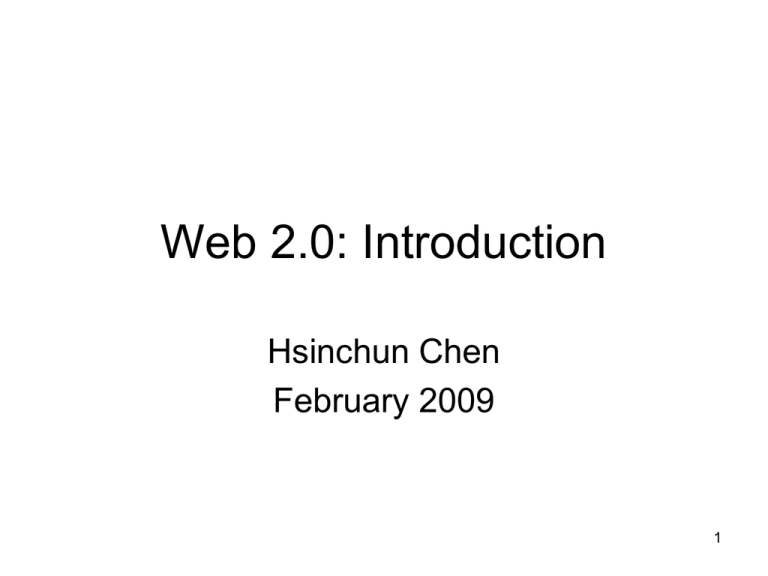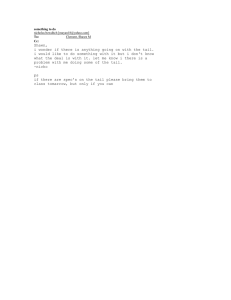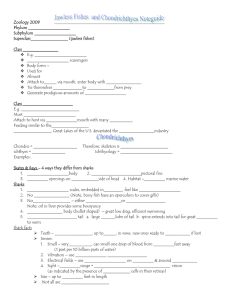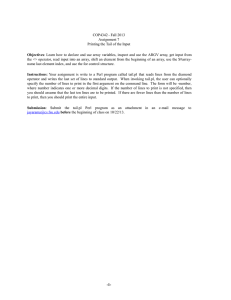
Web 2.0: Introduction
Hsinchun Chen
February 2009
1
Overview
• What is Web 2.0? By Tim O’Reilly
• Web 2.0, Wikipedia
• The Long Tail, By Chris Anderson
2
Web 2.0, by O’Reilly
• http://www.oreilly.com, “What is Web 2.0?
Design Patterns and Business Models for the
Next Generation of Software,” by Tim O’Reilly,
9/30/2005 (O’Reilly Media Web 2.0 Conference,
2004)
• Examples of Web 2.0: Google AdSense, Flikr,
Napster, Wikipedia, blogging, search engine
optimization, web services, participation, tagging
(folksonomy), syndication, etc.
3
Web 2.0, by O’Reilly
• Strategic positioning: “The Web as Platform”
• User positioning: “You control your own data”
• Core competencies:
– Services, not packageg software
– Architecture of participation
– Cost-effective scalability
– Remixable data sources and data transformations
– Software above the level of a single device
– Harnessing collective intelligence
4
Web 2.0 Lessons
• The value of the software is proportional to the scale and
dynamism of the data it helps to manage.
• Leverage customer-self service and algorithmic data
management to reach out to the entire web, to the edges
and not just the center, to the long tail and not just the
head.
• The service automatically gets better the more people
use it.
• Blogging and the wisdom of the crowds.
• Network effects from user participation are the key to
market dominance in the Web 2.0 era.
• We, the media.
• Data is the next Intel inside.
5
Web 2.0 Lessons (cont’d)
• Operations must become a core competency.
• The perpeptual beta.
• Support lightweight programming models that allow for
loosely coupled systems. (SOAP, REST, AJAX, etc.)
• Think syndication, not coordination.
• Innovation in assembly. The Mashups.
• Design for “hackability” and remixability.
• Some rights reserved.
6
Web 2.0, Wikipedia
• “Web 2.0 is a trend in the use of the WWW
technology and web design that aims to facilitate
creativity, information sharing, and collaboration
among users.”
• “Web 2.0 is the business revolution in the
computer industry caused by the move to the
Internet as platform, and an attempt to
understand the rules for success on that new
platform.”
7
Web 2.0 Characteristics
•
•
•
•
•
•
•
•
Rich user experience
User participation
Dynamic content
Metadata
Web standards and scalability
Openness
Freedom
Collective intelligence
8
Web 2.0 Features/Technologies
• Technological infrastructure: server software, content
syndication, messaging protocols, browsers with plug-ins
and extensions, various client applications.
• Cascading Style Sheets (CSS) to separate presentation
from content
• Folksonomy (collective tagging)
• Microformats extending pages with semantics
• REST, XML, JSON based APIs
• Rich Internet application techniques based on AJAX
• RSS or Atom feeds for syndication and notification of
data
• Mashups of content from different sources
• Weblog publishing, and wikis
9
The Long Tail
• “The Long Tail,” by Chris Anderson, WIRED
Magazine, December 2004.
• “Forget squeezing millions from a few megahits
at the top of the charts. The future of
entertainments is in the millions on niche
markets at the shallow end of the bitstream.”
10
The Long Tail (cont’d)
• If the 20th- century entertainment industry was
about hits, the 21st will be equally about misses.
• The constraint of the physical world is physics
itself. In the tyranny of physical space, an
audience too thinly spread is the same as no
audience at all.
• "What percentage of the top 10,000 titles in any
online media store (Netflix, iTunes, Amazon, or
any other) will rent or sell at least once a
month?“
11
The Long Tail (cont’d)
• The Power Law demand curve – the long tail
12
The Long Tail (cont’d)
• Executives at iTunes, Amazon, and Netflix have
discovered that the "misses" usually make
money, too. And because there are so many
more of them, that money can add up quickly to
a huge new market.
• Combine enough nonhits on the Long Tail and
you've got a market bigger than the hits.
• The average Blockbuster carries fewer than
3,000 DVDs. Yet a fifth of Netflix rentals are
outside its top 3,000 titles.
• Google makes most of its money off small
advertisers (the long tail of advertising) and
eBay is mostly tail as well - niche and one-off
products.
13
The Long Tail: Three Rules
• Rule 1: Make everything available
In a Long Tail economy, it's more expensive to
evaluate than to release. Just do it!
• Rule 2: Cut the price in half. Now lower it.
Pull consumers down the tail with lower prices.
• Rule 3: Help me find it
Use recommendations to drive demand down
the Long Tail.
14
Web 2.0 Criticism
•
•
•
•
“Web 2.0 as a piece of jargon,” by Tim Berners-Lee
“A second bubble”
“Bubble 2.0”
“A mere augmentation of current cultural information
exchanges that are bound by existing political and
societal structures.”
15



